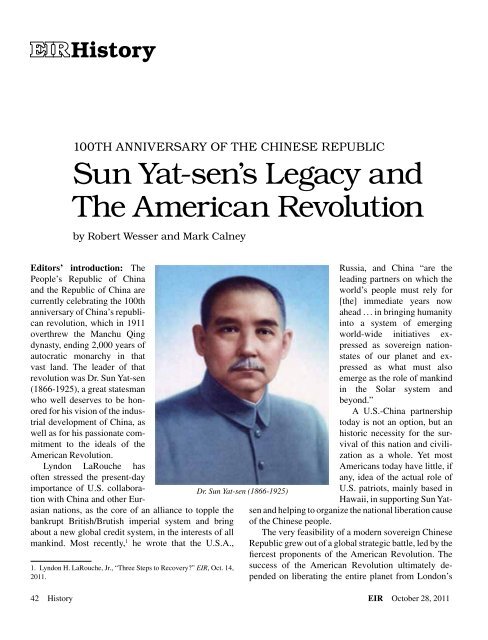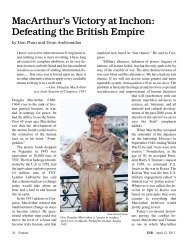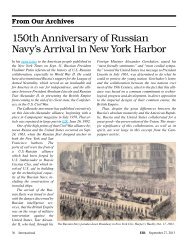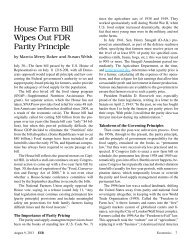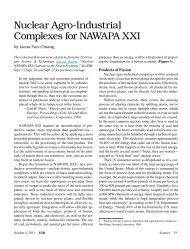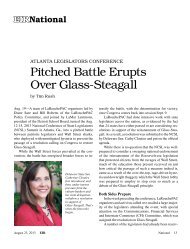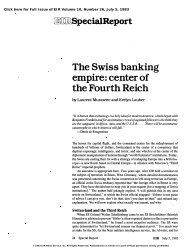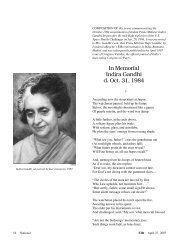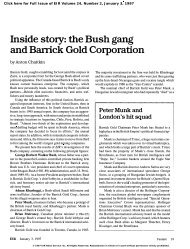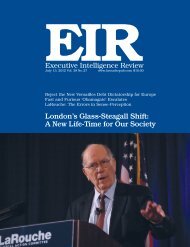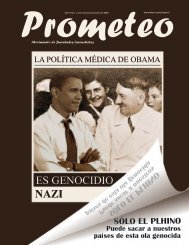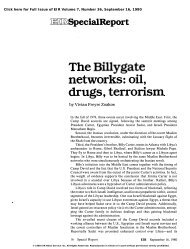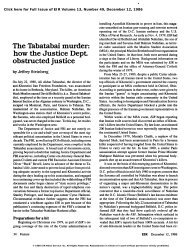Sun Yat-sen's Legacy and The American Revolution
Sun Yat-sen's Legacy and The American Revolution
Sun Yat-sen's Legacy and The American Revolution
Create successful ePaper yourself
Turn your PDF publications into a flip-book with our unique Google optimized e-Paper software.
EIR History<br />
100TH ANNIVERSARY OF THE CHINESE REPUBLIC<br />
<strong>Sun</strong> <strong>Yat</strong>-sen’s <strong>Legacy</strong> <strong>and</strong><br />
<strong>The</strong> <strong>American</strong> <strong>Revolution</strong><br />
by Robert Wesser <strong>and</strong> Mark Calney<br />
Editors’ introduction: <strong>The</strong><br />
People’s Republic of China<br />
<strong>and</strong> the Republic of China are<br />
currently celebrating the 100th<br />
anniversary of China’s republican<br />
revolution, which in 1911<br />
overthrew the Manchu Qing<br />
dynasty, ending 2,000 years of<br />
autocratic monarchy in that<br />
vast l<strong>and</strong>. <strong>The</strong> leader of that<br />
revolution was Dr. <strong>Sun</strong> <strong>Yat</strong>-sen<br />
(1866-1925), a great statesman<br />
who well deserves to be honored<br />
for his vision of the industrial<br />
development of China, as<br />
well as for his passionate commitment<br />
to the ideals of the<br />
<strong>American</strong> <strong>Revolution</strong>.<br />
Lyndon LaRouche has<br />
often stressed the present-day<br />
importance of U.S. collaboration<br />
with China <strong>and</strong> other Eurasian<br />
nations, as the core of an alliance to topple the<br />
bankrupt British/Brutish imperial system <strong>and</strong> bring<br />
about a new global credit system, in the interests of all<br />
mankind. Most recently, 1 he wrote that the U.S.A.,<br />
1. Lyndon H. LaRouche, Jr., “Three Steps to Recovery?” EIR, Oct. 14,<br />
2011.<br />
Dr. <strong>Sun</strong> <strong>Yat</strong>-sen (1866-1925)<br />
Russia, <strong>and</strong> China “are the<br />
leading partners on which the<br />
world’s people must rely for<br />
[the] immediate years now<br />
ahead . . . in bringing humanity<br />
into a system of emerging<br />
world-wide initiatives expressed<br />
as sovereign nationstates<br />
of our planet <strong>and</strong> expressed<br />
as what must also<br />
emerge as the role of mankind<br />
in the Solar system <strong>and</strong><br />
beyond.”<br />
A U.S.-China partnership<br />
today is not an option, but an<br />
historic necessity for the survival<br />
of this nation <strong>and</strong> civilization<br />
as a whole. Yet most<br />
<strong>American</strong>s today have little, if<br />
any, idea of the actual role of<br />
U.S. patriots, mainly based in<br />
Hawaii, in supporting <strong>Sun</strong> <strong>Yat</strong>sen<br />
<strong>and</strong> helping to organize the national liberation cause<br />
of the Chinese people.<br />
<strong>The</strong> very feasibility of a modern sovereign Chinese<br />
Republic grew out of a global strategic battle, led by the<br />
fiercest proponents of the <strong>American</strong> <strong>Revolution</strong>. <strong>The</strong><br />
success of the <strong>American</strong> <strong>Revolution</strong> ultimately depended<br />
on liberating the entire planet from London’s<br />
42 History EIR October 28, 2011
Xinhua<br />
Under a portrait of <strong>Sun</strong> <strong>Yat</strong>-sen, Chinese leaders mark the centenary of the 1911<br />
republican revolution, in the Great Hall of the People in Beijing, Oct. 10, 2011.<br />
<strong>The</strong>re’s more to the story of <strong>Sun</strong>’s life than most <strong>American</strong>s—or Chinese—know.<br />
empire of usury, colonial exploitation, <strong>and</strong> slavery. <strong>The</strong><br />
creation of a world-wide alliance of sovereign nationstates<br />
thus became a strategic necessity, if the inalienable<br />
rights to “life, liberty, <strong>and</strong> the pursuit of happiness”<br />
were in fact to be secured for all of mankind.<br />
It may come as a surprise to <strong>American</strong>s that Dr.<br />
<strong>Sun</strong>’s program for China, the “Three Principles of the<br />
People” (Nationalism, Democracy, <strong>and</strong> People’s Livelihood),<br />
was inspired by Abraham Lincoln’s dedication<br />
to “government of the people, for the people, by the<br />
people,” in his Gettysburg Address. (See box, below,<br />
for <strong>Sun</strong>’s 1912 appeal to the <strong>American</strong> people.)<br />
<strong>Sun</strong> wrote in his 1917 Vital Problem of China that<br />
the wealth of the British Empire was dependent on the<br />
brutal exploitation of abundant slave-labor <strong>and</strong> extractable<br />
resources of the countries of South <strong>and</strong> East Asia:<br />
If one could break this slave-labor empire through the<br />
liberation of these countries <strong>and</strong> the creation of modern<br />
sovereign nation-states in Asia, then this oligarchical<br />
system could be crushed. This was precisely what the<br />
1911 Chinese <strong>Revolution</strong> was all about.<br />
In his 1919 book <strong>The</strong> International Development of<br />
China, he outlined his plans for transforming the nation.<br />
<strong>Sun</strong> wanted to use the most advanced technologies<br />
available, making China a modern industrial state. He<br />
called for building 160,000 kilometers of new railways,<br />
1.6 million kilometers of paved roads, <strong>and</strong> many new<br />
cities, including two new “Gr<strong>and</strong> Port” cities the size of<br />
London <strong>and</strong> New York. China’s hinterl<strong>and</strong>s were to be<br />
colonized <strong>and</strong> developed.<br />
His aim was also to eliminate what he<br />
understood to be the economic roots of a<br />
new world war. “<strong>The</strong> recent World War,”<br />
he wrote, “has proved to Mankind that<br />
war is ruinous to both the conqueror <strong>and</strong><br />
the conquered, <strong>and</strong> worse for the Aggressor.<br />
What is true in military warfare<br />
is more so in trade warfare. I propose to<br />
end the trade war by cooperation <strong>and</strong><br />
mutual help in the Development of<br />
China. This will root out probably the<br />
greatest cause of future wars. <strong>The</strong> world<br />
has been greatly benefitted by the development<br />
of America as an industrial <strong>and</strong><br />
commercial nation. So a developed<br />
China, with her 400 millions of population,<br />
will be another New World in the<br />
economic sense.”<br />
Dr. <strong>Sun</strong>’s life <strong>and</strong> work were com-<br />
memorated by the Beijing government on his 130th<br />
birth anniversary in 1996, 2 when then-President Jiang<br />
Zemin declared that “the goal of invigorating China he<br />
sought all his life <strong>and</strong> the prospects of a modern China<br />
that he had in mind are bit by bit becoming a reality that<br />
has even exceeded his expectations in many ways.<br />
“Dr. <strong>Sun</strong> <strong>Yat</strong>sen left the Chinese nation <strong>and</strong> the Chinese<br />
people many valuable ethical assets, particularly a<br />
rich legacy of patriotic ideas, revolutionary will, <strong>and</strong> an<br />
enterprising spirit—a heritage that is worthy of our efforts<br />
to always learn, inherit <strong>and</strong> carry forward.”<br />
<strong>The</strong> following report is abridged from the articles by<br />
Robert Wesser, “<strong>The</strong> <strong>American</strong> Roots of the Republic<br />
of China, New Federalist, March 22, 1999; <strong>and</strong> Mark<br />
Calney, “<strong>Sun</strong> <strong>Yat</strong>-sen <strong>and</strong> the <strong>American</strong> Roots of China’s<br />
Republican <strong>Revolution</strong>,” New Federalist, March<br />
30, 1990.<br />
An <strong>American</strong> Outpost<br />
In the Pacific<br />
In 1879, the 13-year-old <strong>Sun</strong> <strong>Yat</strong>-sen arrived from<br />
China at the Hawaiian or “S<strong>and</strong>wich” Isl<strong>and</strong>s (henceforth<br />
referred to here as “Hawaii”) to stay with his<br />
brother, who had emigrated there to become a planter<br />
<strong>and</strong> l<strong>and</strong>owner. That is where our story begins.<br />
2. Mary Burdman, “Beijing Celebrates <strong>Legacy</strong> of <strong>Sun</strong> <strong>Yat</strong>-sen, EIR,<br />
Dec. 6, 1996.<br />
October 28, 2011 EIR History 43
In 1879, this isolated archipelago was a battlefield<br />
in the war between the British Empire’s slave-labor apparatus<br />
<strong>and</strong> Benjamin Franklin’s international <strong>American</strong><br />
<strong>Revolution</strong> project. By the time <strong>Sun</strong> arrived there,<br />
this “crossroads of the Pacific” had become a strategic<br />
outpost of this project, deployed through a series of<br />
<strong>American</strong> missionary excursions.<br />
This missionary project was organized by the <strong>American</strong><br />
Board of Commissioners of Foreign Missionaries<br />
(ABCFM), established at Farmington, Conn., in 1810.<br />
A key figure of the ABCFM was Franklin ally Rev.<br />
Jedediah Morse who, after the British takeover of Harvard<br />
College, had set up the <strong>The</strong>ological Seminary at<br />
Andover in 1805, which served as the recruitment <strong>and</strong><br />
educational base of operations for this international<br />
missionary project.<br />
Along with Morse, other founding board members of<br />
the ABCFM included <strong>The</strong> Federalist papers author <strong>and</strong><br />
former Supreme Court Chief Justice John Jay, <strong>and</strong> Congressman<br />
Elias Boudinot IV, the leading House member<br />
of President George Washington’s inner circle, who had<br />
helped secure the appointment of Alex<strong>and</strong>er Hamilton as<br />
first Secretary of the Treasury. Boudinot’s father, Elias<br />
<strong>Sun</strong> <strong>Yat</strong>-sen to <strong>American</strong>s<br />
On the Civil War<br />
<strong>Sun</strong> <strong>Yat</strong>-sen’s 1912 appeal “To the Friends of China<br />
in the United States of America”:<br />
We underst<strong>and</strong> too well that there are certain men of<br />
power—not to include for the present, certain nations—who<br />
would view with a greater or lesser satisfaction<br />
an internal rupture in the new Republic [of<br />
China]. <strong>The</strong>y would welcome, as a move toward the<br />
accomplishment of their own ends <strong>and</strong> designs, a<br />
civil war between the provinces of the North <strong>and</strong> the<br />
South; just as, 50 years ago, there was applause in<br />
secret (in certain quarters) over the terrible civil strife<br />
in the United States.<br />
<strong>American</strong>s of today who were alive in those dark<br />
days of the great republic will remember the feelings<br />
in the hearts of the people—the bitter <strong>and</strong> painful<br />
Boudinot III, had been a member of Ben Franklin’s junto<br />
in Philadelphia, <strong>and</strong> had built Philadelphia’s Second<br />
Presbyterian Church with Franklin in the 1750s.<br />
Most of the leadership of the ABCFM grew out of a<br />
fierce battle between the <strong>American</strong>s <strong>and</strong> the British<br />
over the control of the New York State frontier. <strong>The</strong><br />
British (as well as the French) were notorious for their<br />
brutal corruption <strong>and</strong> exploitation of native <strong>American</strong>s,<br />
organizing <strong>and</strong> in many cases participating in massacres<br />
of pro-independence frontier settlements. By contrast,<br />
the principled <strong>American</strong> approach was typified by<br />
missionary leader Samuel Kirkl<strong>and</strong>, who established a<br />
highly successful school for Oneida Indians in 1793 in<br />
Clinton, N.Y. Later, the school become known as the<br />
Hamilton-Oneida Institute (today Hamilton College),<br />
named for its trustee Alex<strong>and</strong>er Hamilton.<br />
On March 30, 1820, the <strong>American</strong> mission-ship<br />
Thaddeus l<strong>and</strong>ed in Hawaii, carrying a group led by<br />
Hiram Bingham <strong>and</strong> went to work. Within two<br />
years, after the arrival of Scottish missionary Rev. William<br />
Ellis, a written Hawaiian language using five<br />
vowels <strong>and</strong> seven consonants was created. By January<br />
1822, mission printer Elisha Loomis ran off the first<br />
thoughts that arose from the knowledge that foreigners<br />
were hoping <strong>and</strong> praying for the destruction of the<br />
<strong>American</strong> Union.<br />
Had the war been successful from the South’s<br />
st<strong>and</strong>point, <strong>and</strong> had two separate republics been established,<br />
is it not likely that perhaps half a dozen or<br />
more weak nations would have eventually been established?<br />
I believe that such would have been the<br />
result; <strong>and</strong> I further believe that with the one great<br />
nation divided politically <strong>and</strong> commercially, outsiders<br />
would have stepped in sooner or later <strong>and</strong> made of<br />
America their own. I do not believe that I am stating<br />
this too forcibly. If so, I have not read history nor<br />
studied men <strong>and</strong> nations intelligently.<br />
And I feel that we have such enemies abroad as<br />
the <strong>American</strong> republic had; <strong>and</strong> that at certain capitals<br />
the most welcome announcement that would be<br />
made would be that of a rebellion in China against<br />
the constituted authorities.<br />
This is a hard statement to make; but I believe in<br />
speaking the truth so that all the world may know <strong>and</strong><br />
recognize it.<br />
44 History EIR October 28, 2011
<strong>The</strong> East India Company’s Opium War against China, 1939. On<br />
British orders, Hawaii later allowed the mass importation of both<br />
Chinese slave labor <strong>and</strong> opium—measures that the <strong>American</strong>s <strong>and</strong><br />
their allies there fought to abolish.<br />
Hawaiian-language book, an eight-page speller. For 20<br />
years (1822-42), Loomis’s press never rested, printing<br />
Bibles, spellers, psalters, <strong>and</strong> primers. With a written<br />
language established <strong>and</strong> the presses rolling, the Hawaiian<br />
mission, augmented with reinforcements from<br />
Boston, transformed the people of Hawaii forever.<br />
By 1824, the ABCFM missionaries had over 2,000<br />
pupils enrolled in their schools. By 1826, they had<br />
trained 400 native teachers, who assisted in teaching<br />
over 25,000 students, <strong>and</strong> by 1831, 1,100 schools were<br />
educating 40% of the entire population of the Isl<strong>and</strong>s.<br />
By 1843, the mission had converted 27,000 Hawaiians<br />
to Christianity.<br />
Although none were quite as successful as those in<br />
Hawaii, <strong>American</strong> missions ultimately reached Thail<strong>and</strong>,<br />
Africa, the Middle East, Armenia, Greece, India,<br />
Ceylon, <strong>and</strong> China.<br />
Fighting the British Slave System<br />
While the British Empire <strong>and</strong> its North <strong>American</strong><br />
Confederate allies plotted the dismemberment of the<br />
<strong>American</strong> Union, the countries <strong>and</strong> peoples of the Pacific<br />
<strong>and</strong> Far East likewise came under brutal assault by the<br />
British/French-led colonial powers. At the conclusion<br />
of the First Opium War <strong>and</strong> the 1842 Treaty of<br />
Nanjing, the policy of the British Crown was clear:<br />
If you resist the British East India Company’s dopeslavery<br />
“free-trade” empire, you will be crushed by<br />
the full force of the Her Majesty’s gunboats.<br />
As the Royal Navy bombarded China’s relatively<br />
defenseless coastal cities to ruin, Hong Kong<br />
was forcibly ceded to the Empire, <strong>and</strong> the port of<br />
Shanghai forced open to foreign (i.e., British) control.<br />
<strong>The</strong> British ultimately seized four major Chinese<br />
cities (in addition to Canton), while their<br />
French allies gobbled up Vietnam, Cambodia, <strong>and</strong><br />
Laos.<br />
It was precisely in this period (1842) that Andover<br />
<strong>The</strong>ological Seminary graduate Rev. Samuel<br />
Chenery Damon arrived on the scene in Hawaii.<br />
Damon will be a key figure in our story.<br />
In 1833, at the request of <strong>American</strong> mission<br />
leader Hiram Bingham, the ABCFM had established<br />
a Seaman’s Friends Society to counter the<br />
influence of British Consul General Richard Charleton’s<br />
personal organization of pirates <strong>and</strong> sailors<br />
deployed in terrorist gangs to carry out violent attacks<br />
<strong>and</strong> assassination attempts on <strong>American</strong> missionaries.<br />
In 1842, Damon was sent<br />
to Hawaii to run a project,<br />
<strong>and</strong> he proceeded to carry out<br />
this critical <strong>American</strong> intelligence<br />
function for the next 40<br />
years, during the period encompassing<br />
the <strong>American</strong><br />
Civil War. Using the missionary<br />
presses, Damon established<br />
a newspaper called<br />
<strong>The</strong> Friend, which became<br />
the source of Pacific news<br />
<strong>and</strong> intelligence, as well as a<br />
major vehicle through which<br />
to promote the <strong>American</strong><br />
Samuel C. Damon<br />
(1815-85)<br />
cause throughout Asia. Damon became the center of an<br />
extensive <strong>American</strong> Pacific intelligence network <strong>and</strong>,<br />
through constant communication with <strong>American</strong> merchant<br />
<strong>and</strong> Naval captains, received <strong>and</strong> passed on critical<br />
news <strong>and</strong> intelligence.<br />
After an unsuccessful attempt by the Royal Navy to<br />
seize Hawaii by force in 1843, the British escalated<br />
their “free-trade” warfare on the isl<strong>and</strong>s, through the<br />
October 28, 2011 EIR History 45
promotion of a Chinese slave laborbased<br />
plantation system, cartel l<strong>and</strong>grabbing,<br />
<strong>and</strong> opium. British <strong>and</strong><br />
Confederate agents also played the<br />
“ethnic card,” constantly fomenting<br />
racial tensions between the <strong>American</strong>s<br />
<strong>and</strong> the native Hawaiians <strong>and</strong><br />
other ethnic populations of the Isl<strong>and</strong>s.<br />
Samuel Damon, fully conscious<br />
of this British/Confederate<br />
project to bust up the racial harmony<br />
in Hawaii, wrote on the eve of the<br />
<strong>American</strong> Civil War:<br />
“We shall continue to [live in<br />
racial harmony] in our confident<br />
belief, if we continue to treat man as<br />
man, irrespective of color or race; but<br />
a war will come when the wicked<br />
doctrines of the London Times” are<br />
allowed to prevail.<br />
To counter these “wicked doctrines of the London<br />
Times,” Damon <strong>and</strong> others launched a campaign to promote<br />
the cause of the <strong>American</strong> Union in its battle<br />
against the British Empire <strong>and</strong> the Confederacy.<br />
A Union Flank<br />
<strong>The</strong> Union battle against the Confederacy in Hawaii<br />
took the form of a war on the British slave system of the<br />
Pacific: the purchasing <strong>and</strong> selling of “stocks” of Chinese<br />
coolies. <strong>The</strong> powerful <strong>and</strong> highly organized sugar<br />
cane interests in Hawaii (the “planters”) were organized<br />
by the British-run Royal Hawaiian Agricultural<br />
Society to pass a “Masters <strong>and</strong> Servants Law” allowing<br />
mass “importation” of Chinese slave labor. Ultimately,<br />
almost 2,000 Chinese coolies (virtually all men) had<br />
been brought to Hawaii as part of this “trade.”<br />
In the spirit of Alex<strong>and</strong>er Hamilton, Hawaiian Treasury<br />
Secretary Garrit Judd initiated a governmentsponsored<br />
project to provide l<strong>and</strong> <strong>and</strong> cheap credit to all<br />
“commoners” who wished to settle <strong>and</strong> develop agriculture.<br />
Judd’s “Great Mahele” (division of l<strong>and</strong>) was<br />
aimed at busting up the l<strong>and</strong> monopolies of the planters,<br />
<strong>and</strong> eradicating the Chinese slave-labor system in<br />
Hawaii.<br />
Damon, to implement this program, initiated a<br />
project of organizing the newly arrived Chinese population<br />
on the Isl<strong>and</strong>s. In 1868, at Damon’s request, an<br />
ABCFM-sponsored Chinese organizer arrived in<br />
Hawaii <strong>and</strong> began travelling with the <strong>American</strong>s from<br />
<strong>American</strong> President Ulysses S. Grant greets Hawaiian King David Kalakana in 1874.<br />
<strong>The</strong>y signed a “reciprocity treaty” for economic relations of mutual benefit.<br />
isl<strong>and</strong> to isl<strong>and</strong>, to visit all of the Chinese coolie “communities.”<br />
For those who “desired to be taught, <strong>and</strong><br />
whenever teachers [mostly Hawaiian] could be found,”<br />
they organized makeshift schools <strong>and</strong> study sessions.<br />
In the United States, the unprecedented nationalist<br />
mobilization of military <strong>and</strong> economic power required<br />
to defeat the British-backed Confederate insurrection<br />
against the <strong>American</strong> Union, unleashed one of the<br />
greatest explosions of scientific <strong>and</strong> economic progress<br />
in modern history. <strong>The</strong> Union victory demonstrated to<br />
the world that the principles of <strong>American</strong> System economics,<br />
applied under republican constitutional law,<br />
were capable not only of crushing oligarchical attacks,<br />
but could also generate unprecedented rates of scientific<br />
<strong>and</strong> technological advances in “promoting the general<br />
welfare” of mankind.<br />
<strong>The</strong> impact of the Union victory was soon felt in<br />
Hawaii. After the Civil War, in 1872, the first Hawaiian<br />
King travelled to the United States to sign a “reciprocity”<br />
treaty with President Ulysses S. Grant. It is important<br />
to know that the tactic of “reciprocity treaties” was<br />
the <strong>American</strong> System’s answer to British free trade. Instead<br />
of undercutting a targeted nation with cheap<br />
goods <strong>and</strong> slave labor, the reciprocity treaties were negotiated<br />
to organize a “community of principle,”<br />
whereby nations could trade on the basis of bolstering<br />
each other’s economies. <strong>The</strong> 1872 treaty was aimed directly<br />
at the British, as it included a clause whereby<br />
Hawaii promised never to lease or sell any port or l<strong>and</strong><br />
46 History EIR October 28, 2011
<strong>American</strong><br />
System<br />
economist<br />
Henry C.<br />
Carey <strong>and</strong><br />
one of his<br />
many<br />
pamphlets<br />
against<br />
“British free<br />
trade.”<br />
in the kingdom to any power<br />
but the United States!<br />
In 1876, the year of America’s<br />
Centennial, Lincoln ally <strong>and</strong> economist Henry<br />
Carey articulated the <strong>American</strong> System approach to<br />
China <strong>and</strong> other countries under the British boot. He<br />
circulated his pamphlet Commerce, Christianity <strong>and</strong><br />
Civilization Versus British Free Trade: Letters in Reply<br />
to the London Times, which is striking for its scathing<br />
attack on the British East India Company’s murderous<br />
opium-pushing policy against China, as demonstrative<br />
of the actual nature of British free-trade, <strong>and</strong> so-called<br />
“Christian” principles.<br />
Comparing the barbarity of the British Empire to<br />
that of ancient Rome, Carey identified the Union victory<br />
over the Confederacy <strong>and</strong> slavery as an effective<br />
liberation of the United States from “British free-trade<br />
despotism,” creating in America “a growth of internal<br />
commerce that places the country fully on a par with<br />
any other nation of the world.”<br />
<strong>Sun</strong> <strong>and</strong> the <strong>American</strong>s<br />
In 1883, <strong>Sun</strong> <strong>Yat</strong>-sen, then 17 years old, entered<br />
Oahu College (on whose board sat Samuel Damon) in<br />
his final year of a four-year stay in Hawaii. He had spent<br />
the three previous years at the Iolani Bishops School in<br />
Honolulu, run by the Anglican Church, where he<br />
learned English, military exercises, music, <strong>and</strong> mathematics,<br />
<strong>and</strong> was introduced to Christianity. He also was<br />
most certainly introduced to heavy anti-<strong>American</strong> British<br />
propag<strong>and</strong>a by the school’s principal, Bishop Willis,<br />
a staunch monarchist <strong>and</strong> outspoken opponent of the<br />
U.S. annexation of Hawaii. <strong>Sun</strong>’s decision to attend the<br />
<strong>American</strong>-missionary-run Oahu College in 1883 (children<br />
of <strong>American</strong> missionaries also attended<br />
this school) was his first “break”<br />
with the British Empire.<br />
At Oahu, <strong>Sun</strong> was introduced to<br />
Western medicine <strong>and</strong> the principles of<br />
<strong>American</strong> government, <strong>and</strong> considered<br />
going to the United States for future<br />
study. This ended abruptly, however,<br />
when his brother <strong>Sun</strong> Mei became upset<br />
at <strong>Sun</strong>’s leaning toward Christianity <strong>and</strong><br />
the West, <strong>and</strong> sent him back to China. At<br />
the Hong Kong-based Church of Engl<strong>and</strong><br />
Diocesan School, <strong>Sun</strong> met another<br />
young <strong>American</strong> missionary of the<br />
ABCFM, who baptized him a Christian.<br />
In 1886, <strong>Sun</strong> <strong>Yat</strong>-sen returned to<br />
Hawaii <strong>and</strong>, through discussions with<br />
Frank Damon, the son of Samuel<br />
Damon, <strong>and</strong> others, decided to return to Hong Kong for<br />
further study, possibly of medicine. Frank Damon<br />
raised the necessary money from his <strong>American</strong>/Hawaiian<br />
networks for <strong>Sun</strong>’s return voyage to China.<br />
In 1887, <strong>Sun</strong> entered the newly opened Hong Kong<br />
Medical School, where he studied for the next five<br />
years. It was here that he held extensive discussions<br />
with his fellow Chinese students, including Lu Haotung<br />
(the first martyr of the revolution, killed in the<br />
Canton uprising of 1895), on the necessity of a republican<br />
revolution in China. Now a man in his early 20s,<br />
<strong>Sun</strong> became so notorious for his anti-monarchist views,<br />
that he <strong>and</strong> four fellow medical students were labelled<br />
the “four arch rebels.”<br />
In 1875, 120 Chinese students from Canton had<br />
been sent to Hartford, Conn., to master modern <strong>American</strong><br />
industrial <strong>and</strong> military engineering. Organized by a<br />
group of Confucian Chinese nationalists (the “reformers”),<br />
in collaboration with <strong>American</strong> missionary<br />
W.A.P. Martin <strong>and</strong> others, this U.S.-Chinese exchange<br />
program was part of a much broader project to establish<br />
“polytechnic” academies adjacent to military arsenals<br />
October 28, 2011 EIR History 47
<strong>and</strong> sovereign Chinese-run industrial<br />
projects throughout China.<br />
By the late 1880s, some of these<br />
polytechnic schools had become military<br />
academies staffed by <strong>American</strong><br />
<strong>and</strong> German instructors, to train Chinese<br />
cadre in military strategy, industrial<br />
sciences, astronomy, chemistry,<br />
<strong>and</strong> physics.<br />
<strong>The</strong> Chinese organizer of this<br />
program was the famous Confucian<br />
scholar Li Hungchang, who in 1887<br />
was designated by <strong>American</strong> Careyite<br />
Wharton Barker to head up an<br />
<strong>American</strong> project to create a Chinese<br />
National Bank. Barker was an outspoken<br />
proponent of the dismemberment<br />
of the British Empire <strong>and</strong> was a<br />
key operative of the “Philadelphians,”<br />
the <strong>American</strong> “national party.” He proposed<br />
that the Chinese-<strong>American</strong> national bank be established<br />
in order to finance the rapid modernization of China’s<br />
infrastructure.<br />
Earlier, in 1880, Barker had been involved in negotiations<br />
with the Russian Imperial Government to assist<br />
in building warships for the Russian Navy in “immediate<br />
preparation on the part of Russia for a maritime war<br />
with Engl<strong>and</strong> <strong>and</strong> closer political relations with the<br />
people <strong>and</strong> the Government of the United States.”<br />
Barker’s “China modernization project” included a<br />
system of Chinese-run national railways <strong>and</strong> telegraphs,<br />
in which “the advantages resulting from such a<br />
system readily suggest themselves. Among the most<br />
obvious of these may be named the greater commercial<br />
prosperity of the nation, the improvement in the general<br />
condition of the population that must result from intercommunication<br />
between the inhabitants of the village<br />
sections. . . .”<br />
Barker concluded that only the creation of a sovereign<br />
Chinese National Bank could generate the required<br />
credit to finance “all government loans for such public<br />
purposes as the construction of railways, the working of<br />
mines, <strong>and</strong> the contracting for supplies needed for such<br />
undertakings.”<br />
Barker’s National Bank project was aborted in 1888<br />
by pressure from the British on the Manchu Chinese<br />
government. Nonetheless, many Chinese political <strong>and</strong><br />
military leaders allied with <strong>Sun</strong>’s 1911 <strong>Revolution</strong><br />
came out of this operation, <strong>and</strong> its many participants lay<br />
the basis for <strong>Sun</strong>’s later publication<br />
of these infrastructure projects in<br />
detail in his 1919 National Reconstruction<br />
of China.<br />
<strong>The</strong> Eve of <strong>Revolution</strong><br />
On Aug. 1, 1894, war broke out<br />
between Japan <strong>and</strong> China over Korea.<br />
<strong>Sun</strong> <strong>and</strong> his co-conspirators saw that<br />
a defeat for the Manchus by Japan offered<br />
the perfect opportunity for a<br />
revolutionary overthrow of the monarchy<br />
<strong>and</strong> the establishment of a republic.<br />
Accordingly, <strong>Sun</strong> immediately<br />
left for Hawaii to raise the<br />
money from Chinese nationals there<br />
to finance the revolution.<br />
Wharton Barker (1846-1921)<br />
During this period, however,<br />
Hawaii had descended into a virtual<br />
state of civil war between Damon’s pro-Union networks<br />
<strong>and</strong> a British-Confederate operation organized<br />
by ex-Caribbean gun-runner Walter Murray Gibson. By<br />
1882, Gibson had weaseled his way into the confidence<br />
of the Hawaiian King, convincing him that his destiny<br />
lay not with the <strong>American</strong>s, but rather in leading a racially<br />
defined, British-backed “Polynesian Empire”<br />
throughout the Pacific. Showing its true colors, the<br />
Gibson “ethnic Polynesian Empire” gang rammed laws<br />
through the 1886 Hawaiian Assembly “regulating”<br />
(i.e., legalizing) the opium trade. Within months, the<br />
opium traffic on Hawaii grew leaps <strong>and</strong> bounds.<br />
To counter this operation, a small but vigorous opposition<br />
called the Reform Party was formed by Lorrin<br />
Thurston (gr<strong>and</strong>son of the first ABCFM missionary,<br />
Asa Thurston) <strong>and</strong> another “missionary child,” Sanford<br />
Dole. Through their multinational Hawaiian League,<br />
established in January 1887, the <strong>American</strong>s rapidly organized<br />
“rifle clubs” all over Hawaii, bracing for confrontation<br />
with Gibson <strong>and</strong> his dope-pushing syndicate.<br />
By 1887, after ten years of constant political mobilization,<br />
combined with the firepower of the <strong>American</strong> rifle<br />
clubs, the Reform Party <strong>and</strong> the Hawaiian League succeeded<br />
in running Gibson out of the Kingdom.<br />
Finally, in 1894, the year of <strong>Sun</strong>’s return to the Isl<strong>and</strong>s,<br />
the Reform Party seized the entire government<br />
directly by force of arms <strong>and</strong> established the Republic<br />
of Hawaii, with Sanford Dole sworn in as the first President.<br />
In this environment, the <strong>American</strong>s, <strong>and</strong> especially<br />
48 History EIR October 28, 2011
the Hawaiian Chinese community (educated <strong>and</strong><br />
organized for over 25 years by Samuel <strong>and</strong> Frank<br />
Damon), were predisposed more than ever towards<br />
the promotion of republicanism internationally.<br />
Upon <strong>Sun</strong> <strong>Yat</strong>-sen’s return to Hawaii, he lost no<br />
time in organizing his family <strong>and</strong> friends to support<br />
the revolutionary overthrow of the Manchus in<br />
China.<br />
On Nov. 24, 1894, a meeting of approximately<br />
30 people took place in Honolulu, establishing the<br />
conspiratorial Hsing Chung Hui (Restore China Society).<br />
All members were required to take an oath,<br />
placing their h<strong>and</strong>s on the Bible while calling for<br />
the “overthrow of the Manchus, the restoration of<br />
China to the Chinese, <strong>and</strong> the establishment of a<br />
republican government.”<br />
<strong>The</strong> Restore China Society had an initial Hawaiian<br />
membership of just over 100 people, but it<br />
spread like wildfire among the Damon-organized<br />
Hawaiian Chinese. Some of <strong>Sun</strong>’s closest collaborators,<br />
such as his lifelong confidant <strong>and</strong> bodyguard<br />
Chang Chau, came from among the Hawaiian Chinese.<br />
Even <strong>Sun</strong>’s brother was finally convinced, <strong>and</strong> helped<br />
to finance the Chinese <strong>Revolution</strong>. Local chapters<br />
quickly sprang up all over the Isl<strong>and</strong>s, organized anywhere<br />
there were 15 people who were willing to join<br />
the Society. This mode of organizing became the model<br />
for similar chapters on the Mainl<strong>and</strong>, as well as among<br />
overseas Chinese in Europe, the continental United<br />
States, <strong>and</strong> elsewhere in Asia.<br />
According to <strong>Sun</strong> collaborator Chung Kun Ai, it<br />
was Frank Damon who suggested that the Restore<br />
China Society “take up military training to fit ourselves<br />
for leading the revolution in China.” Using wooden<br />
rifles, former Danish captain Victor Bache began military<br />
drill instruction twice a week for Society members,<br />
on the lawn of the home of Frank Damon.<br />
By the end of 1894, with major setbacks to the Manchus<br />
by the Japanese in southern Manchuria, the time<br />
was ripe for an uprising. In January 1895, after receiving<br />
a letter from revolution financier <strong>and</strong> publisher<br />
Charlie <strong>Sun</strong>g, <strong>Sun</strong> <strong>Yat</strong>-sen sailed from Honolulu for<br />
Hong Kong. Accompanying him from Hawaii to join<br />
the revolution were core members of the Restore China<br />
Society recruited from among the Hawaiian Chinese,<br />
along with several Western “specialists” <strong>and</strong> “military<br />
men,” who were recruited to participate in the uprising<br />
in Canton. Henceforth, Hong Kong became the headquarters<br />
for the Restore China Society.<br />
<strong>Sun</strong> <strong>Yat</strong>-sen (with arm raised) <strong>and</strong> comrades establish the Restore<br />
China Society in Honolulu, Hawaii, Nov. 24, 1894. <strong>The</strong>ir aim was to<br />
topple the monarchy <strong>and</strong> establish a republic.<br />
Although the 1895 Canton uprising failed, <strong>and</strong> <strong>Sun</strong><br />
was forced to flee to Japan, a 16-year international organizing<br />
drive was undertaken by him <strong>and</strong> his collaborators<br />
to establish a Republic of China. During this<br />
period, he travelled throughout Europe, Asia, <strong>and</strong> the<br />
United States, establishing Restore China Societies<br />
(later re-named Teng Meng Hui, or, loosely translated,<br />
“the Common Oath Society”), all modelled on the original<br />
chapters in Hawaii.<br />
Exile <strong>and</strong> Return, to Victory<br />
After a successful escape from kidnapping by the<br />
Chinese Legation in London, <strong>Sun</strong> spent two years in<br />
exile in Europe, the first six months of which were devoted<br />
to studies of history <strong>and</strong> literature. This is when<br />
he developed the key principles of the Chinese revolution:<br />
the San Min Chu I or “Three Principles of the<br />
People,” derived from Abraham Lincoln’s concept of<br />
“government of the people, by the people, <strong>and</strong> for the<br />
people.”<br />
In October 1903, as the prospects improved for revolution<br />
in China, <strong>Sun</strong> returned to Hawaii, making a<br />
speech on Dec. 13 which declared that nothing short of<br />
a revolution would save China.<br />
<strong>The</strong> Pacific Commercial Advertiser newspaper covered<br />
the event:<br />
“. . . Dr. <strong>Sun</strong> believes that the Chinese nation will<br />
rise in the might of four hundred millions of people <strong>and</strong><br />
overturn the Manchu dynasty forever. It is his hope also<br />
October 28, 2011 EIR History 49
that upon this Far East revolution a republic will be<br />
erected, for Dr. <strong>Sun</strong> likens the vast provinces of the Chinese<br />
Empire to the States of the <strong>American</strong> Union, needing<br />
only a president to govern all alike.”<br />
<strong>Sun</strong>’s plans to go to Japan were altered when Japan<br />
declared war on Russia on Feb. 10, 1904. Instead, he<br />
organized a trip to the United States. In order to circumvent<br />
the Geary Exclusion Law—prohibiting Chinese<br />
immigration of any kind!—he took advantage of the fact<br />
that Hawaii was now a U.S. Territory <strong>and</strong> became a citizen<br />
of the United States of America! (Through the assistance<br />
of his <strong>American</strong> friends in Honolulu, on March<br />
9, 1904, he signed a deposition certifying that he was of<br />
Hawaiian birth.) He departed for San Francisco from<br />
Honolulu on March 31, on another organizing tour.<br />
His seventh <strong>and</strong> last trip to Hawaii was in early<br />
1911, during his third world tour. From there, he traveled<br />
back to the U.S. <strong>and</strong> was in Kansas City when<br />
word arrived that Gen. Li Yuenhung had secured Wuchang<br />
<strong>and</strong> Hankou on behalf of the republican <strong>Revolution</strong>ary<br />
Army. Within a few months, most of the country<br />
fell to the republicans.<br />
On Jan. 1, 1912, <strong>Sun</strong> <strong>Yat</strong>-sen returned to China <strong>and</strong><br />
was inaugurated the first President of the Republic of<br />
China.<br />
His Chinese friends in Hawaii immediately cabled<br />
Prince Kuhio, the Delegate to the U.S. Congress from<br />
the Territory of Hawaii, to assist in procuring U.S. recognition<br />
of the Republic of China. <strong>The</strong> United States<br />
was the first nation to give the new nation formal diplomatic<br />
recognition.<br />
Recommended Reading<br />
Edward D. Beechert, Honolulu: Crossroads of the Pacific<br />
(Columbia, S.C.: 1991)<br />
Anton Chaitkin, “<strong>The</strong> ‘L<strong>and</strong>-Bridge’: Henry Carey’s<br />
global development program,” EIR, May 2, 1997<br />
Gavan Daws, Shoal of Time: A History of the Hawaiian<br />
Isl<strong>and</strong>s (Honolulu: 1974)<br />
Ralph S. Kuykendall, Hawaii: A History, from Polynesian<br />
Kingdom to <strong>American</strong> State (Englewood Cliffs,<br />
N.J.: 1961)<br />
Toy Len Chang, et al., Sailing for the <strong>Sun</strong>: <strong>The</strong> Chinese<br />
in Hawaii, 1789-1989 (Honolulu: 1988)<br />
Nancy Bukeley Webb, <strong>The</strong> Hawaiian Isl<strong>and</strong>s, from<br />
Monarchy to Democracy (New York: 1956)<br />
From the first issue, datedWinter 1992, featuring Lyndon<br />
LaRouche on “<strong>The</strong> Science of Music:<strong>The</strong> Solution to Plato’s Paradox<br />
of‘<strong>The</strong> One <strong>and</strong> the Many,’” to the final issue of Spring/Summer<br />
2006, a “Symposium on Edgar Allan Poe <strong>and</strong> the Spirit of the <strong>American</strong><br />
<strong>Revolution</strong>,’’ Fidelio magazine gave voice to the Schiller Institute’s<br />
intention to create a new Golden Renaissance.<br />
<strong>The</strong> title of the magazine, is taken from Beethoven’s great opera,<br />
which celebrates the struggle for political freedom over tyranny.<br />
Fidelio was founded at the time that LaRouche <strong>and</strong> several of his close<br />
associates were unjustly imprisoned, as was the opera’s Florestan,<br />
whose character was based on the <strong>American</strong> <strong>Revolution</strong>ary hero, the<br />
French General, Marquis de Lafayette.<br />
Each issue of Fidelio, throughout its 14-year lifespan, remained<br />
faithful to its initial commitment, <strong>and</strong> offered original writings by<br />
LaRouche <strong>and</strong> his associates, on matters of, what the poet Percy<br />
Byssche Shelley identified as, “profound <strong>and</strong> impassioned conceptions<br />
respecting man <strong>and</strong> nature.’’<br />
Back issues are now available for purchase through the Schiller Institute website:<br />
http://www.schillerinstitute.org/about/orderform.html<br />
50 History EIR October 28, 2011


